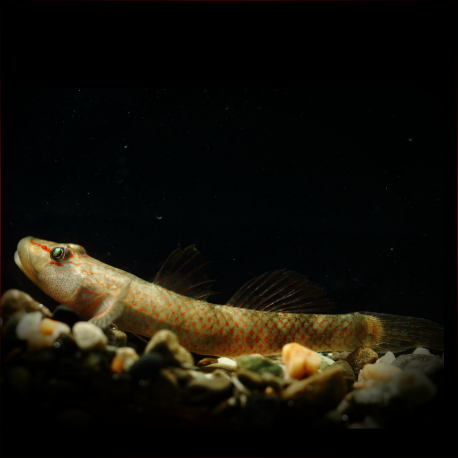More info
Datasheet
| Minimum Tank Size | 60 litres / 15.85 US gallons |
| Maximum Size | 5.0cm / 1.97inches |
| Temperature | 18°C / 64.40°F - 24°C / 75.20°F |
| Hardness | 2.02dgH / 36ppm - 15.02dgH / 268ppm |
| pH | 6.0-8.0 |
General Description
Rhinogobius maculafasciatus is a small species of fish belonging to the Gobiidae family within the Perciformes order. It is characterized by possessing 30-32 longitudinal scales and 6-8 scale rows between the origin of the first dorsal-fin and upper pectoral-fin base. The species is part of the R. brunneus group, sharing specific traits with closely-related species within the genus.
Aquarium Setup
For Rhinogobius maculafasciatus, a tank setup mimicking a flowing stream is recommended. This includes a substrate of rocks, sand, fine gravel, and water-worn boulders. The tank can be decorated with driftwood, terracotta pipes, and plant pots to create hiding spots. It is vital to maintain good water quality with regular 30-50% water changes and ensure high levels of dissolved oxygen.
Behaviour
These gobies are often seen as opportunistic carnivores, feeding on small invertebrates and crustaceans. They display specific reproductive strategies based on their environment, with amphidromous behavior in river-connected species and non-diadromous behavior in landlocked populations.
Feeding and Diet
In the wild, Rhinogobius species feed on small invertebrates and crustaceans. In an aquarium setting, they should be offered small live or frozen foods like chironomid larvae, Artemia, and Daphnia. While they may eventually accept dried foods, these should not be their primary diet.
Reproduction & Dimorphism
The species exhibits different reproductive behaviors, depending on their habitat. Nominal species groups are formed based on similarities in morphology and behavior. The fused pelvic fins, forming a 'pelvic disc,' are a notable feature aiding in their attachment to rocks and submerged surfaces.
Habitat and Distribution
Rhinogobius maculafasciatus is found in the middle and lower parts of rivers in southern Taiwan, particularly in the Tzengwen and Kaoping drainages. Their preferred habitats include small brooks and tributaries with slow water flow, rocky substrates, and pools. Temporary turbidity in streams can occur during periods of high rainfall.

